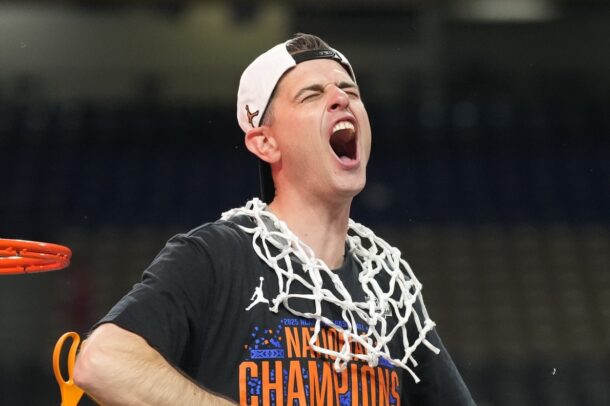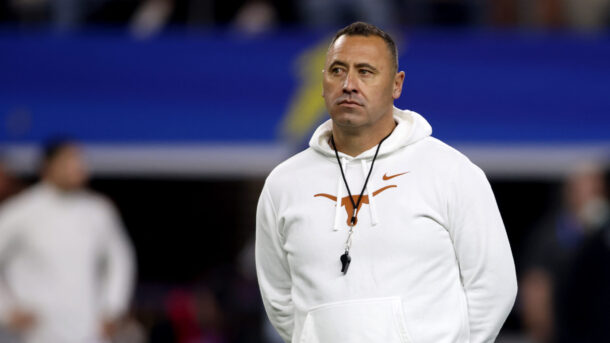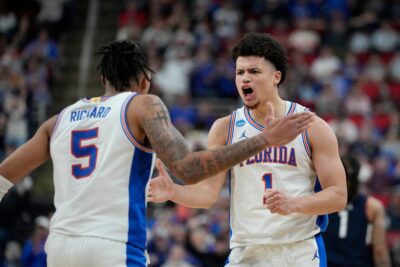Ad Disclosure

It took 40 years, but finally, someone has one-upped the 1985 Big East. The SEC just capped off the best college basketball season ever.
That’s right. It wasn’t just the best season in SEC history; it was the best season ever by a conference.
That’s not just some season-long hype machine for the anti-SEC crowd. Actual numbers back that up, and they’re actual numbers that are only worth referencing because an SEC team cut down the nets for the first time since 2012. If Florida had lost to Houston, this argument wouldn’t exist. History doesn’t crown “impressive Elite Eight representation.”
It does, however, crown conferences that win a title after historic representation at every stage of the season. The SEC had that.
It had a record 14 teams crack the AP Top 25 poll during the regular season, which began with the best nonconference win percentage of any conference since the 1983-84 ACC. And yeah, 14 SEC teams in the NCAA Tournament smashed the 2011 Big East record of 11 (both conferences had 16 teams at the time when they set new marks).
By now, you know all of this. You might also know that there’s a key area where the SEC fell short of the 1985 Big East. It didn’t have a Big East vs. Big East national title game — we haven’t seen an intra-conference national title game since Kansas vs. Oklahoma in 1988 — and instead of having 3 teams in the Final Four, the SEC only had 2. If there’s a hole in the 2024-25 SEC’s argument for G.O.A.T. basketball season by a conference, that’s it. Consider that acknowledged.
Also consider that at every other turn, the SEC clearly had the edge on the 1984-85 Big East.
It’s a difficult side-by-side comp because obviously, we’re comparing a 16-team SEC to a 9-team Big East. Putting 87.5% of its teams in the NCAA Tournament like the SEC did would’ve been impossible for the Big East because the team that finishes 8th in a 9-team conference isn’t sniffing the postseason. But let’s also remember that the final AP Poll used to be voted on before the NCAA Tournament (it also used to be just 20 teams instead of the current 25).
At that point, the Big East had just 3 ranked teams (No. 1 Georgetown, No. 3 St. John’s and No. 15 Syracuse). Compare that to the SEC, who had 4 teams in the top 7 alone and 6 teams in the top 20 of the pre-NCAA Tournament AP Poll.
If the SEC had truly been fraudulent and built on narratives instead of elite basketball, it would’ve had a weak second-weekend presence. Instead, it had 7 of the Sweet 16 teams (a record for any conference) compared to 4 for the Big East. The SEC also had 4 Elite Eight teams (a record that tied the 2009 Big East and 2016 ACC) compared to 3 for the Big East. It was the first time ever that a conference entered the Elite Eight with the possibility of producing the entire Final Four. That didn’t happen, but watching an Elite Eight that had SEC representation in every game was staggering.
Mind you, there was an all-SEC Sweet 16 game (Kentucky vs. Tennessee) and an all-SEC Final Four game (Auburn vs. Florida). The non-SEC teams in the Sweet 16 were 4-10 against the SEC to that point (they finished 8-16). The non-SEC teams in the Elite Eight went 4-6 vs. the conference this season, and all of them lost at least once to an SEC team in 2024-25:
- Duke: 2-1 (lost reg. season to Kentucky)
- Michigan State: 1-1 (lost Elite Eight to Auburn)
- Houston: 1-3 (lost reg. season to Auburn & Alabama, then national title loss to Florida)
- Texas Tech: 0-1 (lost Elite Eight to Florida)
Houston went 34-2 vs. non-SEC teams and 1-3 vs. the SEC. As in, the national runners-up who knocked off mighty Duke. That’s telling.
We can debate the significance of conference supremacy in hoops, but it felt like a real talking point in the Final Four. Duke was considered to be an all-time great team, but because of how few instances it got challenged by the down ACC — it was a 3-bid league that was down to 1 team by the end of Day 3 of the tournament — a young team collapsed in the closing moments against battle-tested Houston.
The inverse was true of Florida, who made a habit of rallying late because 40-minute efforts were demanded in a league as deep as the SEC. A veteran team rose to the occasion and erased a 12-point deficit en route to a comeback victory after leading for just 1:03.
In total, 8 SEC teams finished in the top 25 of KenPom. That’s a record for the KenPom era, which goes back to 2001-02.
That sort of bucks the whole “overrated” notion that had roughly 2 hours of juice during the NCAA Tournament’s opening rounds when the SEC was unable to get off to a 14-0 start. We mustn’t disregard the fact that the SEC also set a record with 13 teams losing a game in the NCAA Tournament (the previous record was 10). Shoot, it would’ve been 14 if not for Florida’s comeback.
(Shoutout Archie Miller and Karl Ravech. They’ll eat that stat up.)
So what does that all mean? Does it mean this 2024-25 season will be what 2006 was for SEC football when it rattled off 7-consecutive national titles by 4 different schools? Given the more random nature of basketball’s postseason tournament, that’s extremely unlikely. More likely, however, is that SEC basketball is at the beginning of its golden age.
Going a decade between Final Four victories made it perfectly fair for there to be SEC skeptics. Now, though, a breakthrough year for the conference feels like a turning point. A league that has spent more on basketball with 6 of the top 12 highest-paid coaches in the sport is positioned to field elite, title-contending teams on an annual basis. This tournament changed the trajectory of the conference’s basketball identity.
A G.O.A.T. year of SEC hoops is in the (record) books.
Connor O'Gara is the senior national columnist for Saturday Down South. He's a member of the Football Writers Association of America. After spending his entire life living in B1G country, he moved to the South in 2015.




